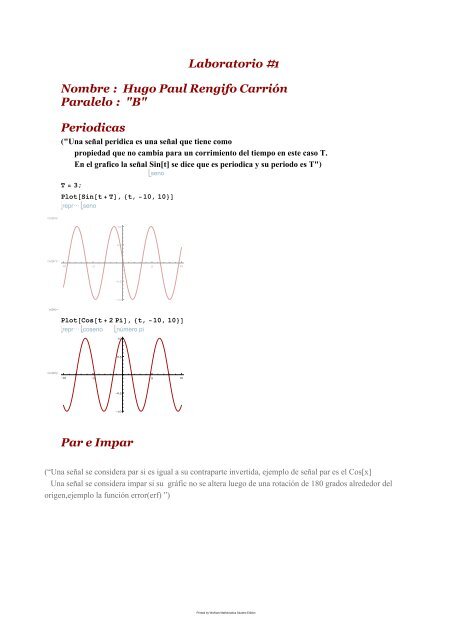representacion-de-senales-en-wolfram-mathematica (1)
Create successful ePaper yourself
Turn your PDF publications into a flip-book with our unique Google optimized e-Paper software.
Laboratorio #1<br />
Nombre : Hugo Paul R<strong>en</strong>gifo Carrión<br />
Paralelo : "B"<br />
Periodicas<br />
("Una señal peridica es una señal que ti<strong>en</strong>e como<br />
propiedad que no cambia para un corrimi<strong>en</strong>to <strong>de</strong>l tiempo <strong>en</strong> este caso T.<br />
En el grafico la señal Sin[t] se dice que es periodica y su periodo es T")<br />
T = 3;<br />
s<strong>en</strong>o<br />
Plot[ Sin[t + T], {t, -10, 10}]<br />
repr⋯ s<strong>en</strong>o<br />
Out[85]=<br />
1.0<br />
0.5<br />
Out[87]=<br />
-10 -5 5 10<br />
-0.5<br />
-1.0<br />
In[98]:=<br />
Plot[ Cos[t + 2 Pi], {t, -10, 10}]<br />
repr⋯ cos<strong>en</strong>o número pi<br />
1.0<br />
0.5<br />
Out[98]=<br />
-10 -5 5 10<br />
-0.5<br />
-1.0<br />
Par e Impar<br />
(“Una señal se consi<strong>de</strong>ra par si es igual a su contraparte invertida, ejemplo <strong>de</strong> señal par es el Cos[x]<br />
Una señal se consi<strong>de</strong>ra impar si su gráfic no se altera luego <strong>de</strong> una rotación <strong>de</strong> 180 grados alre<strong>de</strong>dor <strong>de</strong>l<br />
orig<strong>en</strong>,ejemplo la función error(erf) ”)<br />
Printed by Wolfram Mathematica Stu<strong>de</strong>nt Edition
2 Lab1.nb<br />
In[100]:=<br />
Plot[{-Erf[x],<br />
Erf[-x]}, {x, -10, 10}]<br />
represe⋯ función e⋯función error<br />
1.0<br />
0.5<br />
Out[100]=<br />
-10 -5 5 10<br />
-0.5<br />
-1.0<br />
In[39]:=<br />
Plot[{ Cos[x], Cos[-x]}, {x, -10, 10}]<br />
repre⋯ cos<strong>en</strong>o cos<strong>en</strong>o<br />
1.0<br />
0.5<br />
Out[39]=<br />
-10 -5 5 10<br />
-0.5<br />
-1.0<br />
Expon<strong>en</strong>ciales y S<strong>en</strong>oidales<br />
(“Son funciones las cuales <strong>de</strong>p<strong>en</strong>di<strong>en</strong>do <strong>de</strong>l tiempo su amplitud se ve aum<strong>en</strong>tada, estas<br />
señales son la base fundam<strong>en</strong>tal para crear otras señales mas complejas”)<br />
Plot[ Exp[x], {x, -5, 5}]<br />
repr⋯ expon<strong>en</strong>cial<br />
60<br />
50<br />
40<br />
30<br />
20<br />
10<br />
-4 -2 2 4<br />
Printed by Wolfram Mathematica Stu<strong>de</strong>nt Edition
Lab1.nb 3<br />
Plot[ Exp[-x], {x, -5, 5}]<br />
repr⋯ expon<strong>en</strong>cial<br />
60<br />
50<br />
40<br />
30<br />
20<br />
10<br />
-4 -2 2 4<br />
Plot[ Sin[4 x], {x, -5, 5}]<br />
repr⋯ s<strong>en</strong>o<br />
1.0<br />
0.5<br />
-4 -2 2 4<br />
-0.5<br />
-1.0<br />
Plot[ Sin[x / 2], {x, -10, 10}]<br />
repr⋯ s<strong>en</strong>o<br />
1.0<br />
0.5<br />
-10 -5 5 10<br />
-0.5<br />
-1.0<br />
DiscretePlot[<br />
repres<strong>en</strong>tación discreta<br />
{1.09^n Cos[(2 Pi n) / 15] + 1.09^n Sin[(2 Pi n) / 15], 1.1^n, -1.1^n}, {n, 0, 50}]<br />
cos<strong>en</strong>o número pi<br />
s<strong>en</strong>o número pi<br />
100<br />
50<br />
10 20 30 40 50<br />
-50<br />
Printed by Wolfram Mathematica Stu<strong>de</strong>nt Edition
4 Lab1.nb<br />
DiscretePlot[<br />
repres<strong>en</strong>tación discreta<br />
{0.94^n Cos[(2 Pi n) / 18] + 0.94^n Sin[(2 Pi n) / 18], 0.94^n, -0.94^n}, {n, 0, 50}]<br />
cos<strong>en</strong>o número pi<br />
s<strong>en</strong>o número pi<br />
1.0<br />
0.5<br />
10 20 30 40 50<br />
-0.5<br />
-1.0<br />
Impulso unitario y Escalón unitario<br />
("Una funcion escalon unitario ti<strong>en</strong>e como caracteristica principal que ti<strong>en</strong>e un valor <strong>de</strong> 0 para todos<br />
los valores negativos <strong>de</strong> su argum<strong>en</strong>to y <strong>de</strong> 1 para todos los valores positivos <strong>de</strong> su argum<strong>en</strong>to<br />
Una funcion, el impulso unitario vale 1 solo <strong>en</strong> el argum<strong>en</strong>to y para todos los <strong>de</strong>mas valores toma valor <strong>de</strong> 0")<br />
DiscretePlot[ DiscreteDelta[n], {n, -2, 2}, PlotTheme → "Business"]<br />
repres<strong>en</strong>tación d⋯ <strong>de</strong>lta discreta<br />
tema <strong>de</strong> repres<strong>en</strong>tación<br />
1.0<br />
0.8<br />
0.6<br />
0.4<br />
0.2<br />
0<br />
-2 -1 0 1 2<br />
DiscretePlot[ DiscreteDelta[n - 2], {n, -2, 2}, PlotTheme → "Business"]<br />
repres<strong>en</strong>tación d⋯ <strong>de</strong>lta discreta<br />
tema <strong>de</strong> repres<strong>en</strong>tación<br />
1.0<br />
0.8<br />
0.6<br />
0.4<br />
0.2<br />
0<br />
-2 -1 0 1 2<br />
Printed by Wolfram Mathematica Stu<strong>de</strong>nt Edition
Lab1.nb 5<br />
Plot[ UnitStep[x], {x, -5, 5}]<br />
repr⋯ función paso unidad<br />
1.0<br />
0.8<br />
0.6<br />
0.4<br />
0.2<br />
-4 -2 2 4<br />
Plot[ UnitStep[x - 3], {x, -5, 5}]<br />
repr⋯ función paso unidad<br />
1.0<br />
0.8<br />
0.6<br />
0.4<br />
0.2<br />
-4 -2 2 4<br />
Sumatoria <strong>de</strong> convolucion<br />
(“La convolución <strong>de</strong> señales <strong>en</strong> una manera muy g<strong>en</strong>eral <strong>de</strong> realizar un promediomóvil<br />
y para nuestro caso, convolucionando una señal ruidosa con un filtro respuesta <strong>de</strong><br />
impulso <strong>de</strong> duración finita (FIR), obt<strong>en</strong>emos una señal muy suavizada y filtrada.<br />
Para obt<strong>en</strong>er la salida y[n] <strong>en</strong> un cierto instante fijo n, primero se dibujan h[k] y la versión<br />
“abatida y <strong>de</strong>splazada” x[n-k] sobre el eje k. En segundo lugar, se multiplican<br />
ambas señales para obt<strong>en</strong>er la señal h[k] x[n-k]. Si se suman todos los valores <strong>de</strong> la<br />
nueva señal con respecto a k obt<strong>en</strong>dremos el valor <strong>de</strong> y[n]. ”)<br />
Printed by Wolfram Mathematica Stu<strong>de</strong>nt Edition
6 Lab1.nb<br />
In[78]:=<br />
h = (2)^n UnitStep[-n];<br />
función paso unidad<br />
Z =<br />
UnitStep[n];<br />
función paso unidad<br />
DiscreteConvolve[h, Z, n, m]<br />
convolución discreta<br />
DiscretePlot[%, {m, -10, 10}]<br />
repres<strong>en</strong>tación discreta<br />
Out[80]= 2 m ≥ 0<br />
2 1+m True<br />
2.0<br />
1.5<br />
Out[81]=<br />
1.0<br />
0.5<br />
-10 -5 5 10<br />
Integral <strong>de</strong> convolución<br />
In[40]:= h = Exp[-2 x] UnitStep[x];<br />
expon<strong>en</strong>cial función paso unidad<br />
Out[41]=<br />
Convolve[h, UnitStep[x], x, y]<br />
convoluciona función paso unidad<br />
Plot[%, {y, 0, 10}, PlotRange → All]<br />
repres<strong>en</strong>tación gráfica rango <strong>de</strong> repr⋯ todo<br />
e -y Sinh[y] UnitStep[y]<br />
0.5<br />
0.4<br />
0.3<br />
Out[42]=<br />
0.2<br />
0.1<br />
2 4 6 8 10<br />
Printed by Wolfram Mathematica Stu<strong>de</strong>nt Edition



